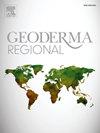Superior nutrient recovery and release by chicken manure-derived biochar over hydrochar and compost for soil fertilization
IF 3.1
2区 农林科学
Q2 SOIL SCIENCE
引用次数: 0
Abstract
Recycling nutrient-rich organic waste materials in agriculture is increasingly recognized for its potential to establish sustainable systems, especially considering the diminishing availability of chemical fertilizers. However, appropriate pretreatment methods are essential for safe and efficient utilization in soil systems. In this study, we compared conventional composting (compost) with low-temperature pyrolysis (biochar) and hydrothermal carbonization (hydrochar) for conserving nutrients from chicken manure (CM) and producing stable organic fertilizer. Biochar exhibited superior nutrient recovery, with 76.4 % of N retrieved from CM compared to 37.4 % for hydrochar and 36.2 % for compost. The escape of NH3 gas from deaminated hydrochar slurry and volatilization loss during composting might have caused such low N recovery in hydrochar and compost, respectively. When applied to soil, biochar released nearly 100 % of its nitrogen in phyto-available form and may satisfy 88.5 % of the N requirements for optimum sweetcorn production. Decomposition of pyridinic- and pyrrolic-N in low-temperature CM biochar might have contributed to this high N release. In contrast, compost released 85 % of its N, and hydrochar released only 33 %. Biochar also preserved the highest amount of carbon (67.6 %) during production, with a significantly higher fixed carbon content (19.2 %). Over a 140-day incubation period, while 26.6 % of compost‑carbon was emitted as CO2 from soil, biochar remained significantly stable (11.5 %). These findings underscore manure biochar's potential as an effective tool for soil fertilization and carbon sequestration, surpassing compost and hydrochar in nitrogen recovery, nitrogen release, and carbon stability in soil.
在土壤施肥中,鸡粪生物炭比碳氢化合物和堆肥具有更好的养分回收和释放
人们日益认识到,在农业中回收富含营养的有机废物具有建立可持续系统的潜力,特别是考虑到化学肥料的供应日益减少。然而,适当的预处理方法是保证土壤系统安全高效利用的关键。在本研究中,我们比较了传统堆肥(堆肥)与低温热解(生物炭)和水热碳化(氢炭)在保存鸡粪(CM)养分和生产稳定有机肥方面的效果。生物炭表现出优异的养分回收能力,从CM中回收了76.4%的氮,相比之下,从水合物和堆肥中回收的氮分别为37.4%和36.2%。脱氨烃类料浆中NH3气体的逸出和堆肥过程中挥发损失可能是导致烃类和堆肥中N回收率较低的原因。施用于土壤时,生物炭以植物可利用的形式释放了近100%的氮,可满足甜玉米最佳产量所需氮的88.5%。低温CM生物炭中吡啶氮和吡啶氮的分解可能是造成这种高氮释放的原因。相比之下,堆肥释放了85%的氮,而碳氢化合物只释放了33%。在生产过程中,生物炭保存了最多的碳(67.6%),固定碳含量显著高于生物炭(19.2%)。在140天的孵化期内,虽然26.6%的堆肥碳以二氧化碳的形式从土壤中排放出来,但生物炭保持显著稳定(11.5%)。这些发现强调了粪肥生物炭作为土壤施肥和固碳的有效工具的潜力,在土壤中氮的回收、氮的释放和碳的稳定性方面超过了堆肥和碳氢化合物。
本文章由计算机程序翻译,如有差异,请以英文原文为准。
求助全文
约1分钟内获得全文
求助全文
来源期刊

Geoderma Regional
Agricultural and Biological Sciences-Soil Science
CiteScore
6.10
自引率
7.30%
发文量
122
审稿时长
76 days
期刊介绍:
Global issues require studies and solutions on national and regional levels. Geoderma Regional focuses on studies that increase understanding and advance our scientific knowledge of soils in all regions of the world. The journal embraces every aspect of soil science and welcomes reviews of regional progress.
 求助内容:
求助内容: 应助结果提醒方式:
应助结果提醒方式:


